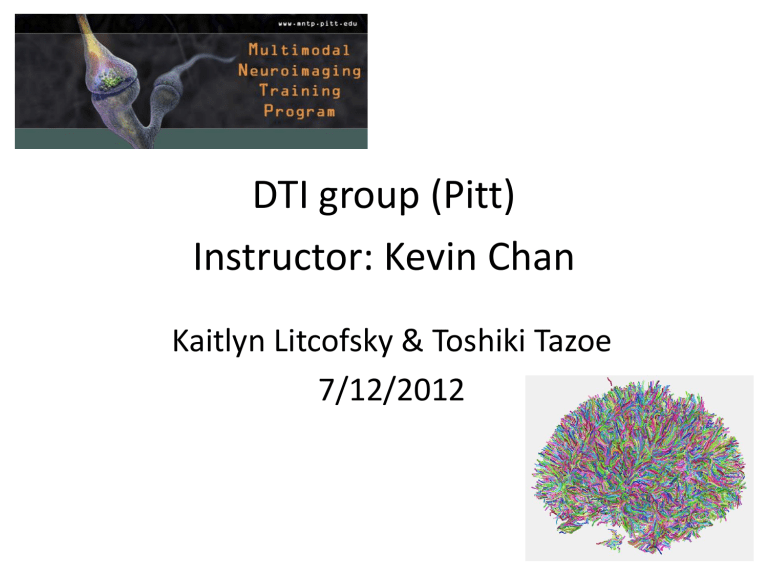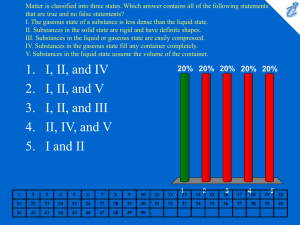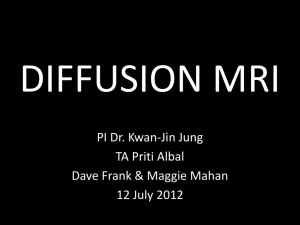Final Presentation of Pitt Group

DTI group (Pitt)
Instructor: Kevin Chan
Kaitlyn Litcofsky & Toshiki Tazoe
7/12/2012
Aims
1. Understand basic principles of MRI
2. Examine factors affecting DWI
1. b-values
2. Gradient direction
3. Examine effect of b-values on DTI
4. Integrate fMRI and DTI
MR signal
S = M
0
・ (1 - e -TR/T1 ) ・ (e -TE/T2 )
Subject 1
TE: 146 ms
TE: 73 ms
TE: 18 ms
TR: 500 ms TR: 6000 ms
MR signal and diffusion
S = M
0
・ (1 - e -TR/T1 ) ・ (e -TE/T2 ) ・ e -bD
= S
0
・ e -bD b = diffusion gradient
D = diffusion coefficient
Gaussian distribution of diffusion
If DW signal comes from free diffusion, gradient magnetic pulse would decay
DW signal mono-exponentially with b-value
Diffusivity across b-value decreases linearly
Diffusion coefficient across b-value is constant
S = S
0
・ e -bD -bD = ln(S/S
0
) D = ln(S/S
0
) / -b b-value b-value b-value
Effect of b-values on DWI: free diffusion?
Water phantom
(NiS04.6H20/NaCL)
Mean DWI (50 directions)
300 b=0 b=500
Signal, DWI
(mm 2 /s)
1200
1000
800
600
400
200
0
0 500 1000 1500 2000 2500 b-value (s/mm 2 )
SNR ≒ 1 b=2000
SNR ≒ 1 b=2500 0 b=1000 b=1500 ln S/S0
0
-0.5
-1
-1.5
-2
-2.5
-3
-3.5
-4
-4.5
0 500 1000 1500 2000 2500 b-value (s/mm 2 )
ADC
(mm 2 /s)
0.0025
0.002
0.0015
0.001
0.0005
0
500 1000 1500 2000 2500 b-value (s/mm 2 )
Effect of b-values on DWI: free diffusion?
Mean DWI (50 directions)
300 b=0 b=500
(mm 2 /s)
250
200
150
100
50
0
0
DWI
500 1000 1500 2000 2500 b-value (s/mm 2 ) b=1000 b=1500
0
-0.5
-1
-1.5
-2 ln(S/S
0
0 500 1000 1500 2000 2500 b-value (s/mm 2 )
) b=2000 b=2500
(mm 2 /s)
0.001
0.0008
0.0006
0.0004
0.0002
0
ADC
500 1000 1500 2000 2500 b-value (s/mm 2 )
WM GM
0
Effect of varied b-values on DWI: gradient direction
R L
DW signal at diffusion gradient (0.79, 0.61, 0.06)
R_Optic_Radiation (Fast) y
L_Optic_Radiation (Slow) x
Fast diffusion Slow diffusion b value (s/mm 2 )
0,9
0,8
0,7
0,6
0,5
0,4
0,3
0,2
0,1
0
Effect of varied b-values on DTI
λ1
Fractional anisotropy: FA Axial diffusivity: λ
//
(mm 2 /s)
0,002
10%
17%
0,0015
0,001
0,0005
0
38%
25% y
500 1000 1500 2000 b-value (s/mm 2 )
2500
500 1000 1500 b-value (s/mm 2 )
2000 2500
Radial diffusivity: λ
⊥
(mm 2 /s)
0,0007
0,0006
0,0005
0,0004
0,0003
0,0002
0,0001
0
500 1000 1500 2000 b-value (s/mm 2 )
21%
30%
2500
Mean diffusivity
(mm 2 /s)
0,0009
0,0008
0,0007
0,0006
0,0005
0,0004
0,0003
0,0002
0,0001
0
500 1000 1500 b-value (s/mm 2 )
2000
37%
20%
2500 z
λ3
WM
GM
λ2 x
Effect of varied b-values on DTI
Voxel-based method, 8 subjects
– Tract-based Spatial Statistics
– FA at b = 1000 s/mm 2 and b = 2500 s/mm 2
P = 0.05
P ≒ 0.00
DTI tractography
• Inputs
– Principal vector
– FA
• Tractography: FACT method
– DTIStudio
– Fiber Assignment by Continuous Tracking (FACT) approach
• Start/Stop tracking threshold: FA = 0.2
• Turn threshold: 70 degrees
DTI tractography by manual ROI
Corticospinal tract
Slice 0 Slice 31
3000
2500
2000
1500
1000
500
0
Number of voxels passed through
500 1000 1500 b value (s/mm 2 )
2000 2500 b=500 b=1000 b=1500 b=2000 b=2500
fMRI data as DTI seed regions
• Compare tractography of posterior visual pathways for upper and lower field visual stimulation at b=1000 s/mm 2 and b=2500 s/mm 2
1.
fMRI vision hemifield task
– Block design
• Rest-Upper-Rest-Lower
• 12 s blocks, 6 repetitions
– TR = 2000 ms
– TE = 26 ms
– 8 subjects
2.
fMRI analysis
– FSL FEAT
Rest
Upper field stimulation
3. Create masks for DTI from fMRI activation maps
Lower field stimulation
fMRI data as DTI seed regions
b = 1000 s/mm 2
Upper visual field stimulation b = 2500 s/mm 2
Lower visual field stimulation
fMRI data as DTI seed regions
1200
1000
800
600
400
200
0 n=8
# of voxels
0,7
0,6
0,5
0,4
0,3
0,2
0,1
0
Mean FA
Conclusions
1. Diffusion is not free / Gaussian-distributed in the brain
– b-values and direction of gradient affects DWI
– b-values affect DTI metrics
Caution has to be taken when interpreting brain DWI/DTI metrics at different b-values
2. Lower b-values (at ~1000 s/mm 2 or 1/ADC) may be more beneficial for evaluating DTI metrics given the higher SNR and potentially smaller errors in estimation
(Jones & Basser, 2004)
3. Higher b-values (e.g., 2500 s/mm 2 ) may be more beneficial for tractography given higher number of voxels traced, likely as a result of greater sensitivity in detecting smaller fibers
(Rane,
Nair & Duong, 2010)
Thank you!
Dr. Kevin Chan
Dr. Seong-Gi Kim
Dr. Bill Eddy
Tomika Cohen
Rebecca Clark
MNTP program







